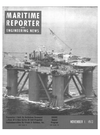
Page 35: of Maritime Reporter Magazine (November 1973)
Read this page in Pdf, Flash or Html5 edition of November 1973 Maritime Reporter Magazine
The Most
Advanced
Electronic System
Which Gives a
Direct Reading of
Shaft Horsepower,
Torque, and RPM
T
AIRDECK pawERjhnquE • EXCELLENT ACCURACY
AND REPEATABILITY • CONVENIENT SMALL SIZE • EASY TO INSTALL
X
ACCEPTED BY
MARITIME
ADMINISTRATION also available: e Total Horsepower Hour • Digital Readouts • Alarms • Torque Limiters
WRITE OR CALL US TODAY
FOR 30 DAYS FREE TRIAL
ULTRA PRODUCTS
INC. 805 Central Ave. • New Orleans, La. 70121 504/835-7191
Opportunities for Sales Representatives
Call or Write us Today 2. OPEN 1. UNLOCK
TIME: 30Seconds
Memarco Rapid Action Deck Cover
The quick, simple way to seal deck openings.
Forget about cumbersome studs and nuts.
Our Rapid Action Deck Cover locks and un- locks in seconds. It fits a standard 12)4" open- ing and is adjustable to any deck plate thick- ness up to 3".
All bronze construction makes it non-spark- ing. Buna-N seal makes it watertight. And, best of all, its removable, special wrench makes it theft proof.
Throw away your old steel plate covers and try ours. You won't be sorry. i—
Mechanical Marine
DIVISION
HAYWARD MANUFACTURING COMPANY, INC. 900 Fairmount Ave., Elizabeth, N.J. 07207
Phone: (201) 351-5400
No. Calif. Section Discusses
Systematic Sequencing For
Loading/Offloading Tankers
Pictured at the Engineers Club, left to right: Joseph Busch (Wickert Co.), chairman, Northern California Section;
Lt. David B. Lorenz (USCG), author, and James A. Stasek (Kings Point Machinery), public relations chairman.
Approximately 60 members and guests of the Northern California Section of The Society of Naval Architects and Marine Engineers at- tended a recent dinner meeting at the Engi- neers Club in San Francisco.
A paper entitled "Systematic 'Sequencing for
Loading and Off-Loading Tankers" was pre- sented by Lt. David B. Lorenz, USiCG, gradu- ate student, University of Michigan.
Lieutenant Lorenz's paper summarized the difficulties in working out tanker loading and discharge sequences by pointing out that there are 480 million possible sequences with only 12 tanks.
He outlined a computer program which se- lects acceptable loading procedures utilizing the "influence line method" traditionally used for analyzing bridge structures and recently adapted for this type of application by J. Moe at the University of Michigan.
Northern California Section officers shown left to right at the meeting: William C. Webster (U.C.), secretary- treasurer; Robert Herbert (naval architect), vice chair- man; Joseph Busch (Wickert Co.), chairman, and Thomas
B. Cole (American President Lines), meetings chairman.
A stated purpose of the paper was to develop discussions which would allow the author to learn more about constraints and considera- tions required to develop a practical program.
Discussion developed that the primary con- siderations should be time, maximum allowable hull stress acceptable to regulatory bodies and low-cycle fatigue limits. Practical usage for this program was suggested as vessels with separate ballasting facilities under 100,000 dwt carrying mutiple petroleum or chemical prod- ucts.
Discussers were: Arthur Haskell, Matson
Navigation ; Henry Kozlowski, American Presi- dent Lines; William Webster, U.C.; Ezio Pal- mieri, Chevron; Robert Boston, USCG; Gra- ham Frazer, Paceco; Robert Herbert, and Bert
Lundegaard.
November 1, 1973 41

 34
34

 36
36
